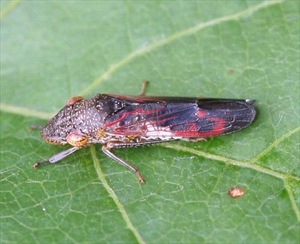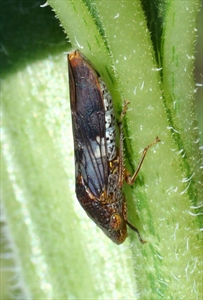Citrus glassy-winged sharpshooter
Pacific Pests, Pathogens, Weeds & Pesticides - Online edition
Pacific Pests, Pathogens, Weeds & Pesticides
Citrus glassy-winged sharpshooter (269)
Homalodisca vitripennis; previously, it was known as Homalodisca coagulata.
North America (widespread, including Hawaii), South America (Chile), Central America (Mexico), Europe (Netherlands), Oceania. It is recorded from Cook Islands, Easter Island, and French Polynesia. The spread of the glassy-winged sharpshooter to the Pacific in recent years is thought to have been helped by air travel.
It has a wide host range, including many species of economic importance, such as almond, avocado, olive, citrus, grape, peach and plum.
The glassy-winged sharpshooter is a large leafhopper (Photos 1&2). It feeds on the xylem or water conducting tubes of plants. Large amounts of fluid pass through its body each day for it to extract sufficient food, and this liquid is expelled as 'leafhopper rain'. It dries leaving a white powder on leaves and fruit which may be unsightly. The sharpshooter does not, however, damage plants by its feeding, apart from causing newly planted citrus to wilt when infested with large numbers of insects.
Eggs are laid side by side - usually 10-12 at a time - under the outer layer of cells on the underside of citrus leaves, and covered in a whitish powder. The eggs hatch in about 10 days, and the nymphs pass through five stages. They are similar to the adults except they are without wings. Adults are cigar-shaped, 12-14 mm long, dark brown to black with lighter undersides. The head is relatively large, narrowing towards the front, with large yellow bulbous eyes. The top of the head is covered in small whitish to yellow dots. Wings are translucent, with reddish veins.
The life cycle is from 35 to 60 days depending on the temperature.
Spread over short distances occurs by flying between trees and to nearby orchards. The adults are attracted to light at night. Nymphs spread occurs by walking and jumping. Spread over longer distances occurs as egg masses on nursery stock or ornamentals.
When numbers are high, the large amounts of liquid discharged from the insects causes a nuisance, especially in places, such as Hawaii and Tahiti, where there is a major tourist industry. Cars, too, become spotted by the liquid excrement.
The insect is an important pest because it spreads a bacterium, Xylella fastidiosa. The bacterium exists as a number of strains that cause, for example, citrus variegated chlorosis disease, olive quick decline syndrome, Pierce's disease of grapes, phony peach disease, plum leaf scald, oleander leaf scorch. Citrus variegated chlorosis is found in Central and South America, mainly on sweet orange, but grapefruit, mandarin, lemon and lime are also susceptible (Photo 3). Leaves show yellowing between the veins (like zinc deficiency), produce many small fruit that ripen early, and the vigour and growth of infected trees is poor.
Nymphs spread the disease, but lose the ability to do so between moults. Once adults are infected, they remain so for the rest of their lives. As the glassy-winged sharpshooters feed, the Xylella bacteria enter their bodies and multiply; later, the bacteria are transferred to healthy plants. Once plants are infected, there is no cure from any of the Xylella diseases.
There is concern that Xylella might be present in countries in plants that do not show symptoms. If the glassy-winged sharpshooter was to be introduced, however, it could transfer the bacterium to commercial or native plants of importance.
The glassy-winged sharpshooter is a relatively large insect, but it is not easy to detect. It moves quickly to the other side of twigs or branches when it sees movement and, because of its colour, it blends in well with its surroundings. Look for the fine whitish powder that coats leaves and fruits. Look for the distinctive tan or brown scars left by the egg masses after they have hatched. Use yellow sticky traps in the orchard.
QUARANTINE
The principal method of controlling this disease is to keep it out of the country, and this requires careful monitoring by biosecurity personnel. As a minimum, planes and cargo bins should be carefully inspected, and/or treated in the countries where the glassy-winged sharpshooter is established (in particular Cook Islands, French Polynesia and the USA). If it is accidentally introduced, management then requires the use of biocontrol.
Internal quarantines can slow the spread of the glassy-winged sharpshooter if they restrict the free movement of planting material from infested to healthy areas. Nursery stock, in particular, should be carefully inspected before shipment and upon arrival. Inspection should look for egg masses.
NATURAL ENEMIES
Wasp egg parasitoids, Gonatocerus species (predominantly Gonatocerus ashmeadi and Gonatocerus fasciatus), give good control of glassy-winged sharpshooter populations. In 2005, Gonatocerus ashmeadi was released in Tahiti and, within 7 months, the glass-winged sharpshooter was controlled completely.
CHEMICAL CONTROL
In general, insecticides are not recommended; they are expensive and will kill the wasp parasitoids. They may be useful, however, in eradication programs, and to slow spread of the Xylella diseases. They have been used mostly on grapes. If needed, use the following:
- Insecticidal soap and oils. They are effective against nymphs (and less toxic to the wasp parasitoids); they must contact the insects, so thorough coverage of the foliage is needed. Repeat at 7-10 day intervals.
- Imidacloprid. This is applied either as a foliar spray or to the soil. The soil application lasts longer and does less harm to wasp parasitoids.
____________________
When using a pesticide, always wear protective clothing and follow the instructions on the product label, such as dosage, timing of application, and pre-harvest interval. Recommendations will vary with the crop and system of cultivation. Expert advice on the most appropriate pesticides to use should always be sought from local agricultural authorities.
AUTHOR Grahame Jackson
Information from Varela LG, et al. (2019) Glassy-winged sharpshooter. University of California Statewide IPM Program. Agriculture and Natural Resources, University of California. (http://www.ipm.ucdavis.edu/PMG/PESTNOTES/pn7492.html); and from Citrus variegated chlorosis (CVC). Xyllela fastidiosa Well et al. USDA, University of Florida. (http://idtools.org/id/citrus/diseases/factsheet.php?name=Citrus+variegated+chlorosis+%28CVC%29); and from CABI (2015) Homalodisca vitripennis (glassy winged sharpshooter) Crop Protection Compendium. (https://www.cabi.org/cpc/datasheet/27561).
Photo 1 Johnny N. Dell, Bugwood.org. Photo 2 Russ Ottens, University of Georgia, Bugwood.org. Photo 3 Alexander Purcell, University of California, Bugwood.org.
Produced with support from the Australian Centre for International Agricultural Research under project PC/2010/090: Strengthening integrated crop management research in the Pacific Islands in support of sustainable intensification of high-value crop production, implemented by the University of Queensland and the Secretariat of the Pacific Community.






